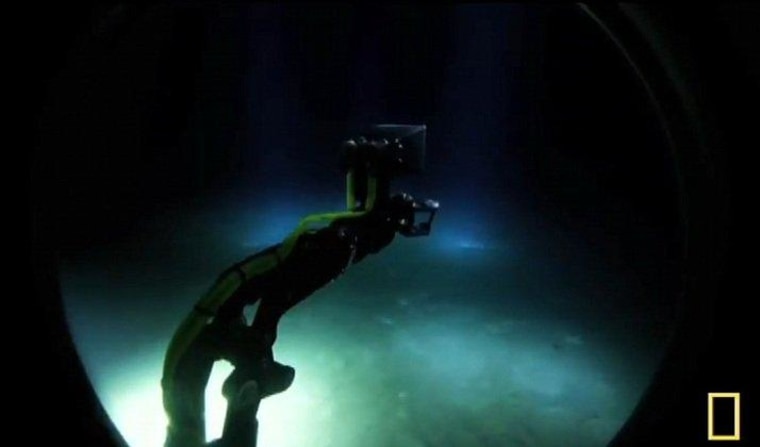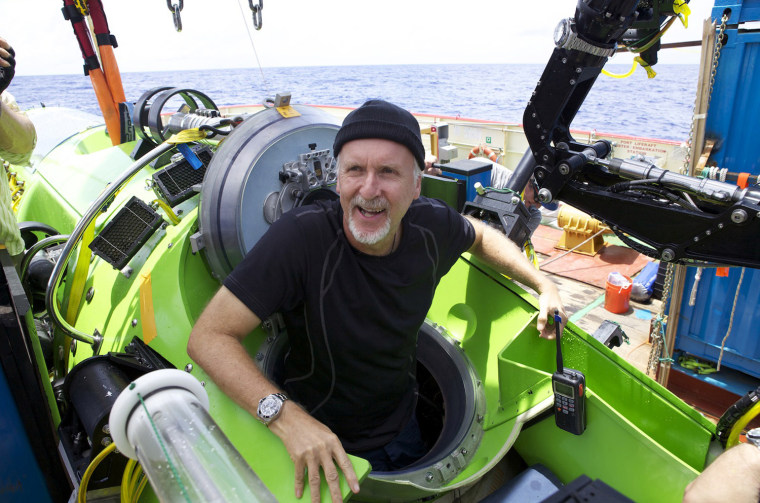More than a month after his record-setting solo dive to the bottom of the ocean, filmmaker James Cameron is fleshing out his adventure tale with personal details as well as comparisons to another one of his passions — space exploration. The story hit TV screens tonight on "James Cameron: Voyage to the Bottom of the Earth," a half-hour documentary premiering on the National Geographic Channel.
The main thrust of the story unfolded back on March 26: Cameron climbed into a custom-built submersible called the Deepsea Challenger and plunged nearly 36,000 feet (10,898 meters) to the bottom of the Mariana Trench. It's the deepest part of the ocean— reached only once before, by a two-man team in 1960.
Cameron recounted his adventure in a teleconference with reporters just after the trip, but during tonight's show, documentary footage added more color to the account. For example:
- The sea was unsettled in the days leading up to the dive, and at one point Cameron thought he would have to choose between making the attempt and attending the blockbuster premiere of "Titanic 3-D." If he missed the premiere, he said, the top movie executives behind the film release might never speak with him again. Fortunately, the weather cleared just in time to satisfy Cameron's tight schedule.
- Cameron's wife, Suzy Amis, gave him a good-luck smooch before the dive. "Is this going to be a PDA?" Cameron asked, using the acronym for a public display of affection. "Yup," Amis said. Cameron said that when he was at the very bottom, he took a phone call from Amis, "which of course was very sweet ... but let that be a lesson to all men: You think you can get away, but you cannot."
- The last guy to speak to Cameron before the dive, and the first guy Cameron spoke to after surfacing and climbing out of the Deepsea Challenger, was Don Walsh, who made the 1960 trip down to the bottom along with Jacques Piccard on the Trieste. "I'm glad it's you that's taking back the record," Walsh told Cameron beforehand. Afterward, Cameron told Walsh, "Hasn't changed a bit since you were down there."
- Cameron described the bottom of the seafloor as looking like "white Latex paint on a sheet of masonite." He extended the Deepsea Challenger's robot arm to collect a soil sample, but the hydraulic system sprung a leak just as he was extracting it. All he was left with was seawater with a bit of sediment at the bottom. He also lost his ability to move around the bottom, due to a thruster malfunction. "I was done," he said. "It was time to come back." Fortunately, the system for dropping two 600-pound blocks of ballast and sending the submersible back up to the surface worked as planned. "If this doesn't work, it's going to be a bad day," he recalled thinking at the time.
Cameron has been in the news lately not only for his deep-sea adventure, but also for his role as an adviser to Planetary Resources, the venture that is building spacecraft to identify and mine near-Earth asteroids. Cameron made the connection between the deep sea and outer space when he described how the Deepsea Challenger kicks up sediment when it reaches the seafloor. "It was just like landing a spaceship — it was the coolest thing."


The outer-space angle came out in a statement about the show issued before tonight's premiere: "More money gets put into space exploration, but the ocean is our life support here on spaceship Earth. And we’re destroying it faster than we're exploring it," Cameron said. "I think it draws attention to the ocean and the lack of funding for ocean exploration."
Cameron also touched on that concern last week in a Q&A with The Hollywood Reporter, in which he said the lesson from the Deepsea Challenger's dives was that "a small group of privately funded, passionate young engineers can come up with something that governments can't do." The Hollywood Reporter's Patrick Brzeski went on to ask what that meant for the bigger picture, and here's part of Cameron's reply:
"Well, first it means, as governments, whether it's the U.S. or any other government, we've lost our edge when it comes to exploration — whether it's space or unexplored corners of the oceans. And secondly, there are a lot of new technologies and advancements being made in material sciences that allow us to do things at a fraction of the price that it would have been previously. That allows private individuals to come into the game. Those two factors combined are making exciting things happen. You see the same thing in space, with Jeff Bezos and Elon Musk. You know, Elon Musk's SpaceX is going to be regularly orbiting vehicles to service the International Space Station. They basically stepped into the shoes of NASA — for a fraction of the price. That’s a better business model than doing deep ocean exploration. I hate to even use the term entrepreneurial for what we’re doing, because entrepreneurial implies that there’s going to be some big profit at the end if you’re successful. But really for me the end result is the science and exploration and the imagery we’re getting. It's not a profitable thing — we aren't doing it because we expect to find oil and gold down there. But see, the thing is, you never really know where pure research is going to take you. The New Britain Trench — at 27,000 feet — no one had ever been down there to look at it. In one dive, in the first five minutes, I discovered two new species. In the first five minutes of being on the bottom!"
In the interview, Cameron also referred to his well-known efforts to take a trip into space himself and make a movie, either on Russia's Mir space station (before it was deorbited in 2001) or the International Space Station (before the Columbia tragedy in 2003). If last year's rumors turn out to be true, Cameron just might finally get his chance to film the final frontier, perhaps during a round-the-moon odyssey.
He might have to hold off on his next real-life adventure until he gets "Avatar 2" and "Avatar 3" into the theaters. But whether that next adventure involves outer space or the sea, I have a feeling it's going to be a doozy.
More about James Cameron and exploration:
- James Cameron's deep-sea team goes back for more
- Cameron's dive stirs call for more deep-sea exploration
- Filmmaker/explorer unfurls Explorer's Club flag
- Asteroid mining crazy? So is deep-sea drilling
"James Cameron: Voyage to the Bottom of the Earth," airs again on the National Geographic Channel on May 3, 6 and 10. Check listings for times in your area.
Alan Boyle is msnbc.com's science editor. Connect with the Cosmic Log community by "liking" the log's Facebook page, following @b0yle on Twitter or adding Cosmic Log's Google+ page to your circle. You can also check out "The Case for Pluto," my book about the controversial dwarf planet and the search for other worlds.